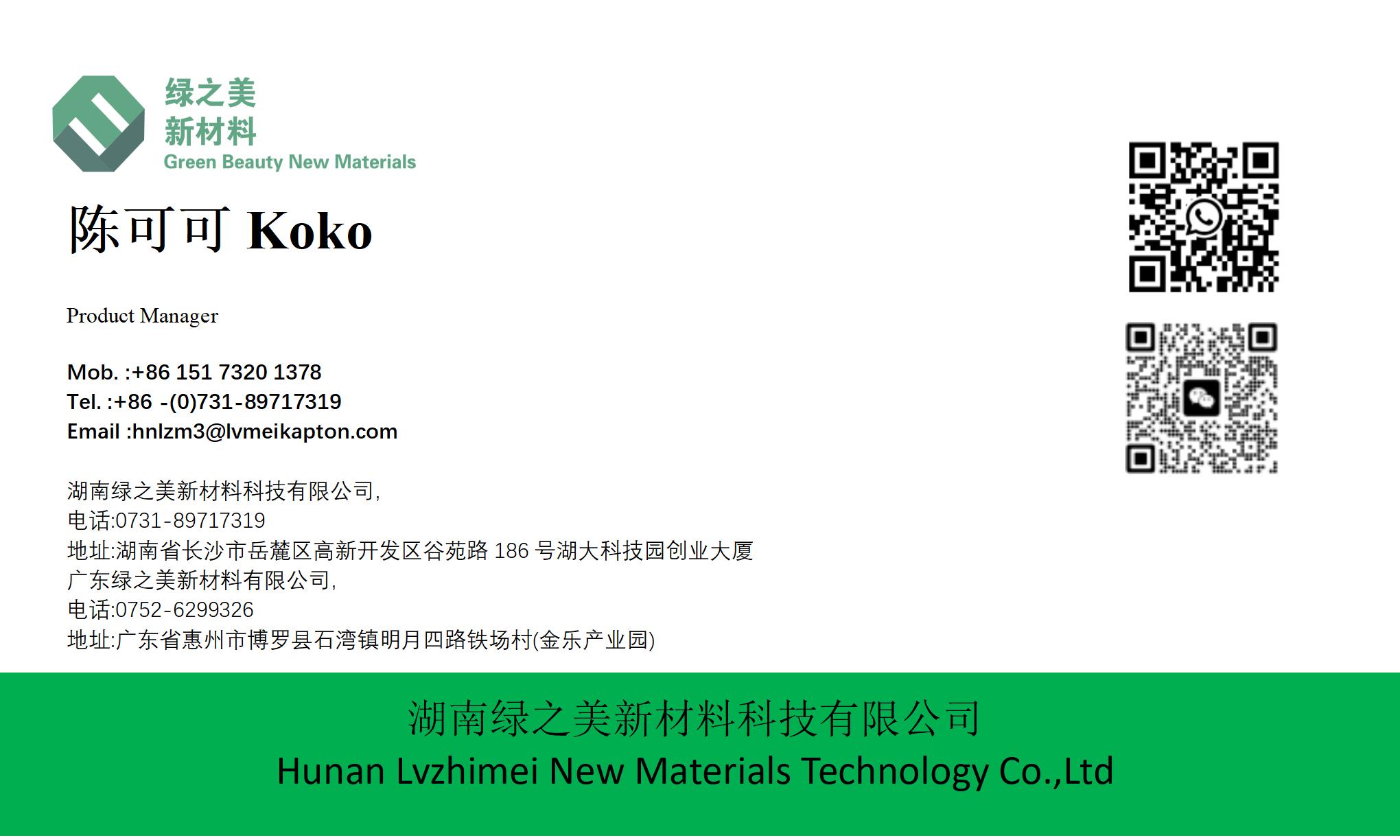hnlzm@lvmeikapton.com
+86 13787123465


Hunan Lvzhimei New Material Technology Co., Ltd.


NameDescriptionContent
How Does Lvmeikapton’s Adhesive Technology Enhance Tape Performance? |https://www.lvmeikapton.com/
Source:
|
Author:Koko Chan
|
Published time: 2025-05-22
|
7 Views
|
Share:
This article delves into the adhesive formulations used in Lvmeikapton insulating electrical tape, focusing on silicone and acrylic options. It examines how these adhesives impact performance characteristics, substrate compatibility, curing processes, and environmental resilience. Case studies highlight real-world applications, while future advancements in adhesive science are explored to anticipate industry trends.
How Does Lvmeikapton’s Adhesive Technology Enhance Tape Performance?
Abstract: This article delves into the adhesive formulations used in Lvmeikapton insulating electrical tape, focusing on silicone and acrylic options. It examines how these adhesives impact performance characteristics, substrate compatibility, curing processes, and environmental resilience. Case studies highlight real-world applications, while future advancements in adhesive science are explored to anticipate industry trends.
Keywords: Lvmeikapton adhesive technology, silicone vs. acrylic, tape performance
1. IntroductionLvmeikapton, a renowned brand in high-performance insulating tapes, has revolutionized electrical applications through advanced adhesive technologies. Traditional tapes often struggle with thermal stability, residue accumulation, or insufficient bonding strength. Lvmeikapton addresses these challenges by integrating specialized adhesives—silicone and acrylic—tailored for diverse industrial needs. This article elucidates how these formulations enhance tape performance across critical parameters.
2. Silicone Adhesives: High-Temp Stability and Residue-Free RemovalLvmeikapton’s silicone adhesives are formulated with organosilicon polymers, offering exceptional thermal stability up to 300°C for short-term exposure and 180°C for prolonged use. This resilience stems from the adhesive’s ability to maintain cohesive strength and adhesion even under extreme heat, preventing degradation or delamination.
Key advantages include:
●
Residue-Free Removal: Unlike conventional tapes, Lvmeikapton’s silicone adhesive leaves no residual adhesive upon removal, preserving substrate integrity. This feature is vital in applications like printed circuit board (PCB) manufacturing, where clean surfaces are imperative.
●
Chemical Resistance: Silicone’s inert nature resists acids, alkalis, and solvents, ensuring tape functionality in corrosive environments.
●
Low Outgassing: Compliant with NASA outgassing standards, these adhesives emit minimal volatile compounds, making them suitable for aerospace and medical devices.
Table 1: Comparison of Silicone Adhesive Performance
Parameter | Lvmeikapton Silicone Adhesive |
Max Temperature | 300°C (short-term), 180°C (long-term) |
Dielectric Strength | ≤8.5 kV |
Residue After Removal | None |
Chemical Resistance | Acid/Alkali/Solvent-resistant |
3. Acrylic Adhesives: Strong Initial Tack for Immediate BondingFor applications requiring rapid assembly or temporary fixes, Lvmeikapton employs acrylic-based adhesives. These formulations exhibit high initial tack, allowing immediate bonding without prolonged curing times. Their advantages include:
●
Quick Bonding: Acrylic adhesives achieve 70-80% of full strength within minutes, ideal for production lines with high throughput.
●
Versatility: Compatible with a wide range of substrates (e.g., metals, plastics, textiles), they adapt to diverse manufacturing environments.
●
UV Resistance: Modified acrylics resist ultraviolet degradation, prolonging outdoor equipment lifespan.
However, acrylic adhesives have limitations: they may exhibit lower thermal resistance (up to 150°C) and leave minor residues if removed improperly. Lvmeikapton mitigates these issues through proprietary curing processes and surface treatments.
4. Adhesive Selection Based on Substrate (Copper, FR-4, Polyimide)Optimal tape performance hinges on adhesive-substrate compatibility. Lvmeikapton’s technology accounts for material properties:
Copper: Silicones dominate due to their thermal stability, preventing oxidation during soldering processes. Acrylics are used for temporary electrical connections.
FR-4 (PCB Material): Balanced adhesion is crucial. Lvmeikapton combines silicone’s heat resistance with acrylic’s initial tack, ensuring secure bonding during thermal cycling.
Polyimide (Kapton): Self-adhesive tapes leverage silicone’s conformability to match Kapton’s flexibility. This synergy enables reliable insulation in high-voltage environments.
5. Case Study: Medical Device Bonding with Low-Outgassing AdhesivesIn medical device assembly, Lvmeikapton’s silicone adhesive demonstrated superior performance. A cardiovascular implant manufacturer faced challenges with adhesive residue contaminating electrodes, causing device failures. Switching to Lvmeikapton tape resolved the issue:
●
Outcome:
a.
100% reduction in residue-related defects.
b.
Adhesive outgassing decreased by 90% (meeting ISO 10993 biocompatibility standards).
c.
Long-term stability in sterilization cycles (up to 50 cycles at 121°C).
This case underscores how Lvmeikapton’s technology aligns with stringent medical regulations, enhancing product reliability.
6. Adhesive Cure Times and Process IntegrationCuring processes significantly influence production efficiency. Lvmeikapton offers two curing strategies:
●
Room Temperature Cure (RTC): Acrylic tapes bond within 24 hours, suitable for manual assembly.
●
Heat Accelerated Cure: Silicone tapes achieve full strength in 10 minutes at 150°C, integrating seamlessly with automated soldering lines.
Table 2: Curing Comparison
Adhesive Type | Cure Time (RTC) | Accelerated Cure (150°C) |
Silicone | 24 hours | 10 minutes |
Acrylic | 24 hours | N/A |
7. Environmental Factors Affecting AdhesionHumidity and temperature fluctuations challenge adhesive performance. Lvmeikapton addresses these through:
●
Humidity Resistance: Silicones retain adhesion in 95% RH environments, preventing "fish-eye" delamination common in acrylics.
●
Thermal Cycling: Proprietary crosslinking agents ensure adhesion stability through -40°C to 200°C cycles, critical for automotive electronics.
●
UV Protection: Acrylics are UV-stabilized, maintaining tack outdoors for >2 years.
8. Future Developments in Adhesive ScienceLvmeikapton’s R&D aims to push performance boundaries:
●
Nano-Adhesives: Embedding nanoparticles (e.g., graphene) could enhance thermal conductivity and mechanical strength.
●
Smart Adhesives: Self-healing polymers that autonomously repair micro-cracks, extending tape lifespan.
●
Bio-Based Formulations: Sustainable adhesives derived from renewable resources (e.g., lignin), reducing carbon footprints.
Collaborations with academic institutions and materials science labs are driving these innovations.
9. ConclusionLvmeikapton’s adhesive technology transforms tape performance through tailored formulations, substrate compatibility, and environmental resilience. Silicone and acrylic systems address specific application needs, from high-temperature electronics to rapid medical device assembly. Ongoing advancements promise even greater durability, sustainability, and adaptability, solidifying Lvmeikapton’s leadership in insulating tape innovation.



Hunan Lvzhimei New Material Technology Co., Ltd.
Quick Links
Product Categories
© 2024 Hunan Lvzhimei New Material Technology Co., Ltd.All Rights Reserved. Designed by Erge
0731 - 89717319
hnlzm@lvmeikapton.com
+86 13787123465
Room 502, Chuangye Building, No186, Guyuan Road, High-Tech District, Changsha, Hunan, China
CONTACT



